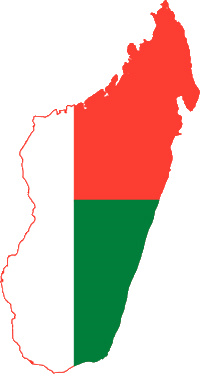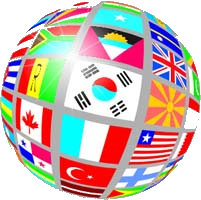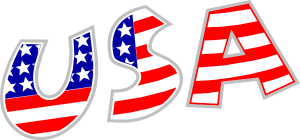Madagascar -- School-age
Madagascar
Official Name: Republic of Madagascar
Repoblikan'i Madagasikara Republique de Madagascar
Government Type: Semi-presidential Republic
Capital: Antananarivo.
County's inhabitants: Malagasy
Abbreviation: MG
Currency: Malagasy Ariary (AR, MGA)
Languages: Malagasy and French

Madagascar is the world's fourth largest island.
Madagascar is a Southern Africa island off the east coast of Africa in the Indian Ocean.
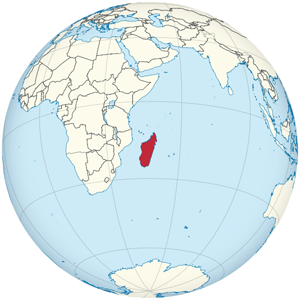
Government
Madagascar’s constitution was written and adopted in 1992. It created a semi-presidential system.
The president is elected by the public for a term of five years and is only allowed to serve two terms. The national assembly (legislature) nominates a prime minister from one of their own and the president approves the nomination. The prime minister recommends cabinet ministers to advise the president, and the president approves the nominations.
The president and prime minister work closely. The president is Chief of State and represents the country and is in charge of foreign policy. The prime minister is in charge of the legislative and judicial branches and creates and executes laws.
Flag of Madagascar
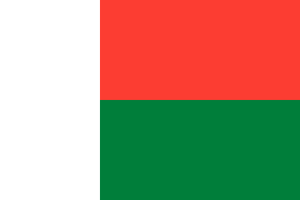
The Madagascar flag was officially adopted on October 14, 1958, two years before the independence of that nation.
Madagascar gained full independence from France in 1960.
The flag of Madagascar is a tricolor. It has two horizontal bands and a vertical band. The vertical band is white in color and located on the hoist side of the flag. The horizontal bands are of red and green colors. The red and white colors of the flag come from the original colors of the Merina kingdom, the ancient Kingdom of Madagascar. The color green represents the peasant class, agriculture, and symbolizes hope.
Land
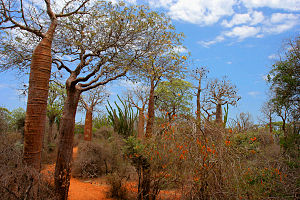
The south area of the island is characterized by desert and spiny forests.
Grass covers most of the island. The island's remaining tropical rainforest is located on a steep slope along Madagascar's eastern coast. Along the coastlines are coral reef and mangrove swamps. In the central highlands is the most densely populated part of the island with grassy hills, subhumid broadleaf forest, and terraced rice-growing valleys.
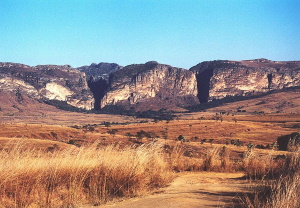
Grassy plains dominate the western landscape, dotted with stony massifs, patches of deciduous forest, and baobab trees.
Climate
Madagascar has a tropical climate with two seasons. A rainy season (December-April) and a dry season (May-November). The island is heavily exposed to tropical cyclones which bring torrential rains and destructive floods.
Plants

Baobab Tree
Over 1,000 species of orchids grow on the Madagascar island.
The poinciana is the national flower of Madagascar. The Royal Poinciana or Flamboyant (Delonix regia) is a flowering tree with vivid red/yellow flowers and bright green foliage.

Poinciana
Animals
Because of Madagascar's isolation most of its mammals, half its birds, and most of its plants exist nowhere else on earth.
Lemurs live in the wild only on the African island of Madagascar and
a few neighboring islands.
TheLemur is a tree-hopping, furry primate.<
The Lemurs, Ring-Tailed is the national animal of Madagascar.
Aye Aye ia a species of lemur.
Video
creature feature
One of the largest geckos in Madagascar.
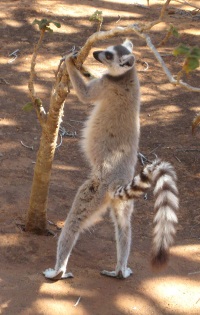
Ring-tailed Lemur
Lowland Streaked Tenrec
lives mainly in the rainforests in Madagascar.
Fossa
The fossa is Madagascar's largest mammal, a cat-like, carnivorous mammal.
Video
Madagascar Is Famous For
Madagascar is famous for its flora and fauna. Almost 90 percent of the plants and animals on Madagascar are not found anywhere else in the world.
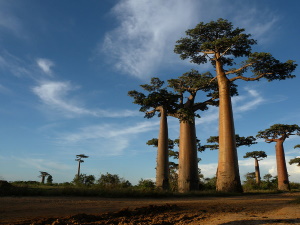
Baobab Trees in Madagascar.
Madagascar Products
Madagascar is a poor country. Most Malagasy people work in agriculture growing crops and cattle called zebu. The main food crop is rice. Vanilla and cloves are grown to sell to other countries.
The top items that Madagascar exports are vanilla, nickel, cobalt, knit sweaters, and cloves.
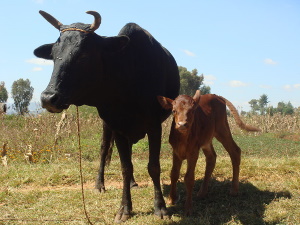
Zedu cow and calf in Madagascar.
Madagascar is the world’s leading producer of vanilla. Madagascar supplies 80% of the world's vanilla. Vanilla is the second-most-expensive spice in the world (saffron is the most expensive).
Vanilla Video
Things to Do
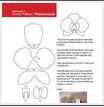
Make Paper Orchids (school-age
Print the template, color, cut, glue.
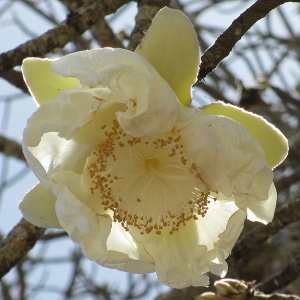
Baobab Flower
Draw a baobab tree and paint it black (sponge paint). Baobab trees have white flowers. Make paper tissue flowers and add to the top part of the tree.
Tissue Paper Flower Craft Make Tissue Paper Flowers
Sites to See
Read
Screensaver
(pbs site)
Fun Facts
The true Malagasy serves his meal, as is done in most parts of Africa, on a mat on the floor. Everything is put down at the same time--but in the cities individual plates are used and the utensil is a large spoon (no knives or forks are used).
Recommended Books
Tree of Life: The World of the African Baobab
by Barbara Bash
Little Lemur Named Mew by Joyce Powzyk

